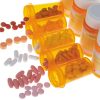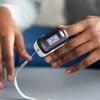- Empty cart.
- Continue Shopping
How to Use a Thermometer Correctly

A thermometer is a valuable tool used for measuring temperature accurately. Whether you are checking your body temperature when feeling under the weather or monitoring the temperature of food during cooking, using a thermometer correctly is essential to obtain accurate results.
Types of Thermometers
Before we delve into how to use a thermometer correctly, let’s briefly explore the various types of thermometers available:
1. Digital Thermometer
Digital thermometers are widely used for their accuracy and ease of use. They come in various forms, including oral, ear, and forehead thermometers. Some digital thermometers can also be used to measure the temperature of liquids and surfaces.
2. Infrared Thermometer
Infrared thermometers, also known as non-contact thermometers, measure temperature from a distance. They are commonly used in industrial settings but have become increasingly popular for personal use due to their speed and non-invasive nature.
3. Analog Thermometer
Analog thermometers, such as the traditional mercury thermometer, are less common today but are still found in some households. They require careful handling and are considered less accurate than digital or infrared thermometers.
Now that we have an understanding of the types of thermometers available, let’s move on to the steps on how to correctly use them.
How to Use a Digital Thermometer
Digital thermometers are user-friendly and provide quick and accurate temperature readings. Here’s how to use them correctly:
Step 1: Prepare the Thermometer
- Wash Your Hands: Start by thoroughly washing your hands with soap and water to prevent any contamination.
- Clean the Thermometer: If it’s a multi-use thermometer, make sure it is clean and sanitized. Follow the manufacturer’s instructions for cleaning and maintenance.
Step 2: Position the Thermometer
- Choose the Appropriate Site: Depending on the type of digital thermometer you have, decide where to take the measurement. Common sites include the mouth, ear, or forehead.
- Oral Measurement: For oral readings, place the thermometer tip under your tongue, close your mouth, and breathe through your nose. Ensure the thermometer is in full contact with the tongue.
- Ear Measurement: If using an ear thermometer, gently insert the probe into the ear canal and follow the device’s instructions.
- Forehead Measurement: For a forehead thermometer, hold it against the center of your forehead and follow the manufacturer’s instructions for proper usage.
Step 3: Take the Measurement
- Wait for the Reading: Digital thermometers typically provide a signal, such as a beep, when the reading is complete. Keep the thermometer in place until you hear this signal.
- Record the Temperature: Once the reading is complete, note the temperature displayed on the screen. Some thermometers may automatically store the reading for you.
Step 4: Clean and Store
- Clean the Thermometer: After use, clean the thermometer probe with a disinfectant wipe or as per the manufacturer’s instructions.
- Store Properly: Store the thermometer in its protective case or according to the manufacturer’s guidelines.
How to Use an Infrared Thermometer
Infrared thermometers are incredibly convenient for measuring temperature without direct contact. Here’s how to use them correctly:
Step 1: Prepare the Thermometer
- Check the Batteries: Ensure that the infrared thermometer has sufficient battery power to operate.
- Clean the Lens: Wipe the lens of the infrared thermometer with a clean, dry cloth to remove any dust or debris that could affect accuracy.
Step 2: Aim and Shoot
- Position the Thermometer: Stand a few inches away from the object or person whose temperature you want to measure.
- Aim the Infrared Beam: Point the thermometer at the target area, making sure the infrared beam covers the entire surface you intend to measure.
Step 3: Take the Measurement
- Press the Trigger: Squeeze the trigger button to initiate the temperature reading. Some models may also have a “scan” button.
- Wait for the Reading: The thermometer will provide an almost instant temperature reading on its display.
Step 4: Record and Store
- Note the Temperature: Record the temperature reading for future reference if needed.
- Power Off: Turn off the infrared thermometer to conserve battery life.
How to Use an Analog Thermometer
Analog thermometers, like mercury thermometers, require more care and attention during use. Here’s how to correctly use them:
Step 1: Prepare the Thermometer
- Inspect for Damage: Check the thermometer for any cracks or damage. If it’s damaged, do not use it, as it can be dangerous.
- Shake Down the Mercury: If you’re using a mercury thermometer, shake it down to ensure the mercury level is below 95°F (35°C).
Step 2: Position the Thermometer
- Choose the Measurement Site: Determine the appropriate site for measurement, such as the mouth, armpit, or rectum.
- Oral Measurement: Place the thermometer tip under your tongue, close your mouth, and hold it in place.
- Armpit Measurement: If measuring under the armpit, make sure the armpit is dry and place the thermometer there, holding the arm down to keep it in place.
- Rectal Measurement: For rectal readings, use a lubricant and gently insert the thermometer into the rectum, following the thermometer’s instructions.
Step 3: Take the Measurement
- Wait for the Reading: Keep the thermometer in place for a sufficient amount of time, usually 2-3 minutes for an accurate reading with a mercury thermometer.
- Read the Temperature: Carefully observe the level of the mercury or the indicator on the thermometer to determine the temperature.
Step 4: Clean and Store
- Clean the Thermometer: After use, clean the thermometer thoroughly with soap and water, especially if used rectally. Be cautious not to expose the thermometer to excessive heat or direct sunlight.
- Store Safely: Store the analog thermometer in a protective case or container, keeping it away from children to prevent breakage and mercury exposure.
General Tips for Thermometer Use
Regardless of the type of thermometer you use, here are some additional tips to ensure accurate temperature measurements:
- Read the Instructions: Always refer to the manufacturer’s instructions for your specific thermometer model. Each type and brand may have unique guidelines.
- Keep Still: While taking your temperature, try to remain as still as possible to avoid errors in the reading.
- Avoid Eating or Drinking: Refrain from eating or drinking hot or cold substances for at least 15 minutes before using a thermometer, as it can affect the reading.
- Regular Calibration: If possible, have your thermometer calibrated periodically to ensure accuracy.
- Check for Fever Guidelines: Familiarize yourself with the guidelines for normal body temperature and fever for the age group you are measuring.
In Conclusion, Using a thermometer correctly is essential for obtaining accurate temperature readings, whether for medical purposes or cooking. Different types of thermometers require specific techniques, so it’s crucial to follow the appropriate steps outlined in this guide. Remember to always prioritize safety and hygiene when using thermometers, and consult a healthcare professional if you have concerns about your body temperature or health. With the right knowledge and technique, you can confidently and accurately measure temperature whenever the need arises.








